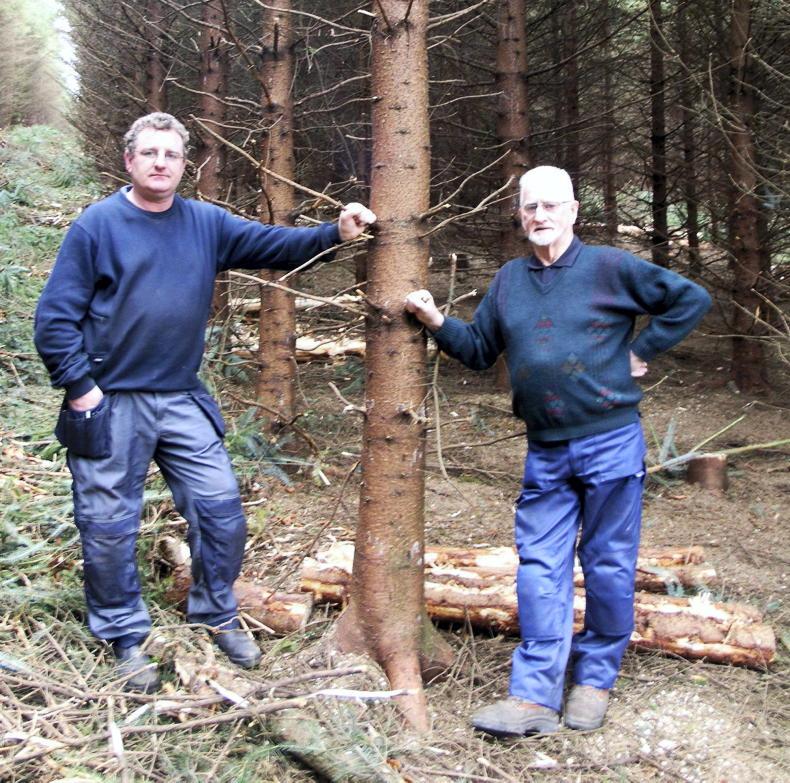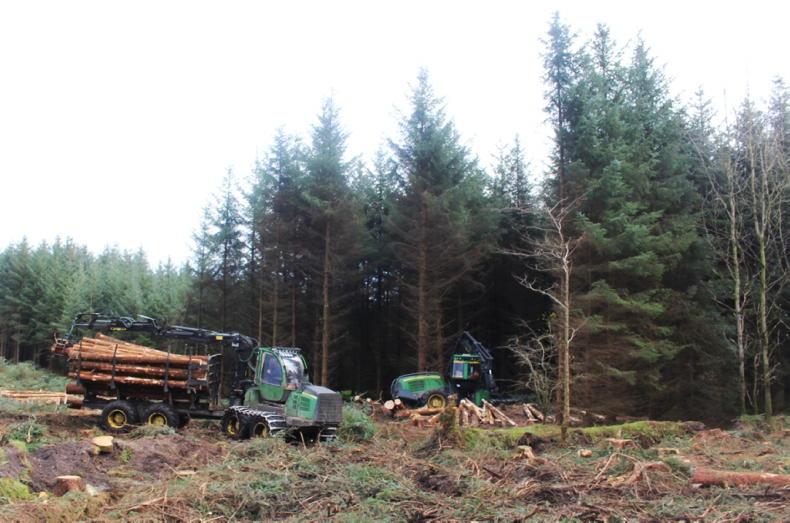In November 2009, the McCarney family were carrying out the first thinning of their forest in Minvaud Lower, 4km south of Hacketstown, Co Carlow. When I visited the site at the time, the forest was a hive of activity. Harvesting operators John Paul Doyle and Mick O’Toole were carrying out the thinning operation and John Wolohan was loading stakewood, which was transported to Woodfab sawmill in Aughrim, Co Wicklow.
In November 2009, the McCarney family were carrying out the first thinning of their forest in Minvaud Lower, 4km south of Hacketstown, Co Carlow.
When I visited the site at the time, the forest was a hive of activity. Harvesting operators John Paul Doyle and Mick O’Toole were carrying out the thinning operation and John Wolohan was loading stakewood, which was transported to Woodfab sawmill in Aughrim, Co Wicklow.
The late Gerry McCarney and his son Conor, along with Jim Hurley, then with Forwood, were also on the site discussing future management plans.
Jim Hurley’s advice at the time was to thin regularly to maximise the quality and volume of the final crop. In all, the McCarneys have carried out three thinnings and when I visited the site last week, they were clearfelling part of the forest.
Now 12 years on, the regular thinning has paid off, as first clearfelling is being carried out on 10.8ha, while 4.2ha that was planted later is due a further thinning and will be clerfelled in a few years’ time, so a mixed-aged forest will continue to evolve.
The forest is bustling with activity and many of the personnel present 12 years ago are back. Sadly, Gerry McCarney passed away eight years ago, but his son Conor and daughter Ciara Johnson were present, along with Jim Hurley, now director of Euroforest, and Jordan Foxton, one of the company’s newest forestry managers.
Harvester operator John Paul Doyle was also back and nearby, Donal Kearney, the forwarder operator, was extracting the timber to roadside where haulier Jimmy Byrne was loading the sawlog bound for the Murray Timber Group sawmill in Ballon. Noel Lanigan had just loaded and left with stakewood for Woodfab and a stack of pulpwood was awaiting removal to Wicklow Port where it will be exported to Britain.
In addition to having a free-draining mineral soil ideal for forestry, the McCarney forest has the added advantage of location. Both Woodfab and Murray mills are less than 25km away, while Wicklow Port is only 50km to the east.
While most of the material in 1992 was pulpwood with some stakewood, the product mix this time around reflects the wisdom of the thinning policy adopted.
“The volume removed comprises 73% large and medium sawlog, 10% boxwood or pallet, 8% stakewood and 9% pulpwood,” said Jordan Foxton.
The crop is yielding of 440m3/ha. “The average tree size is in the 0.6m3 to 0.7m3 range, which is much larger than similar-aged unthinned crops,” said Jim Hurley.
“If the crop hadn’t been thinned, the low-value pulpwood content could be as high as 30% instead of 9%.”
While timber prices have fallen in recent weeks by between 15% and 20%, standing prices for large sawlog are making close to €100/t or approximately €82/m3.

Conor McCarney and his late father Gerry in 1992 when Minbaud was being first thinned. \Donal Magner
Decision to plant
The 30 years since the forest was established have flown by. When asked about the decision to plant, Conor McCarney explains that most of the family income came from off-farm work before planting, as both he and his father had careers outside of farming.
“The farm carried sheep, cattle and even a portion of it had sugar beet, but the income wasn’t sufficient to support a family,” he said.
“We needed a land use that wasn’t demanding when we returned from our work, which often took us some distance away.”
Forestry seemed like a good choice in what was ultimately a lifestyle decision, he explained.
“It was my father’s dream project and he spent a good deal of time walking and inspecting the trees as the forest developed.”
What next
The clearfelled area will be reforested with Sitka spruce and will also include a mixture of native broadleaves. Ideally, replanting should take place in the spring, but Euroforest is discussing chipping 90% of the lop and top in an experimental biomass project with Bord na Móna.
The income from this is modest, but it has the added advantage of providing an easy to plant site, which requires no windrowing of lop and top, so there are major cost savings. Windrowing is the mechanical removal of tree branches and tops into lines to facilitate planting after clearfelling.
Although chipping will delay planting until next autumn to allow the lop and top to dry, ground preparation and replanting will be much easier to carry out. Also, this approach facilitates ease of access and regular inspection of the new tree crop, an advantage that Gerry McCarney would surely have appreciated.
No timber prices made available for Coillte
or private sales
For the first time in a number of years, timber price information hasn’t been made available for Coillte or private sales.
The producers of Wood Price Quarterly (WPQ), which provides private standing timber prices, were unable to provide price data this year.
This collaboration between UCD and the Irish Timber Growers Association (ITGA) has also been seriously curtailed due to lack of price data supplied to WPQ by forestry companies, consultants and timber processors.
Coillte has also withdrawn its wood price quarterly data. The company “took a decision earlier this year not to publish quarterly prices as the market was in turmoil”.

Working in harmony: Donal Kearney, extracts Sitka spruce sawlog felled by harvester John Paul Doyle in Minbaud forest. \Donal Magner
Changing position
A company spokesperson said: “We have also had to consider our changing position in the market with the growth of the private sector. We now consider this information, if published on a quarterly basis, to be commercially sensitive.”
Timber production from private growers is estimated to double over the next few years, so it is vital to have regular and accurate price data available.
It is important that forest owners, forestry companies and sawmillers make log prices available to WPQ on a confidential basis through roundwooddatabase@ucd.ie.





SHARING OPTIONS: